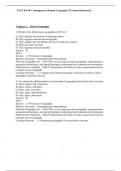Tentamen (uitwerkingen)
Test Bank For Contemporary Human Geography 5th Edition by James Rubenstein. Full chapters.
- Vak
- Instelling
Test Bank For Contemporary Human Geography 5th Edition by James Rubenstein. ISBN: 9780137631513. Contemporary Human Geography 5e test bank. James Rubenstein 5e test bank for Contemporary Human Geography.
[Meer zien]




